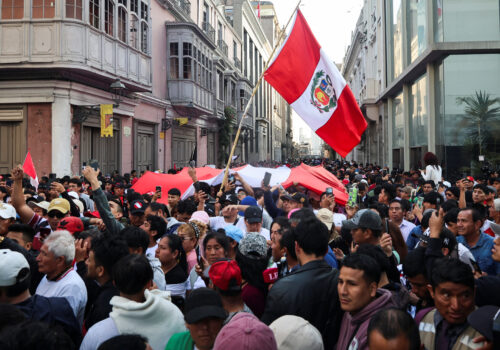One year into Claudia Sheinbaum’s presidency, Mexico has maintained stability but faces mounting tests in economic growth and institutional resilience. When Mexico’s first female president took office in October 2024, she declared it was “time for transformation, and time for women.” A month later, US President Donald Trump’s reelection to the White House shifted the international spotlight to her northern neighbor. As a result, much of the commentary fixated on how Mexico’s presidenta would “get along” with the men who shaped her political past, present, and future: Trump and former Mexican President Andrés Manuel López Obrador (known as AMLO).
One year in, Sheinbaum has made clear that she is not defined by their legacies or actions. Her mandate, and that of her National Regeneration Movement (Morena) party is rare since Mexico’s democratization at the turn of the century. In the June 2024 elections, the president’s party unlocked a lower chamber supermajority and a Senate majority, giving Sheinbaum a rare latitude to enact her agenda. And a year into her term, her approval rating remains high—78 percent, according to an Enkoll poll released this month.
Domestically: Quick yet targeted wins
What’s behind this approval rating? For one, quick and targeted wins. Early in her administration, Sheinbaum secured several quick but meaningful gains with key constituencies. For example, she enshrined several social programs as constitutional rights and enacted the Pensión del Bienestar para Mujeres, which expands pensions to women aged sixty to sixty-four. Early this year, Sheinbaum implemented a 12 percent minimum wage hike, except in Mexico’s more industrialized northern states, which saw a smaller adjustment given their already-higher wages. This nearly nationwide minimum wage hike surpassed Mexico’s 3.76 percent inflation rate, meaning it actually improves the purchasing power of the population.
Internationally: Pragmatic yet similar to AMLO
On the international front, Sheinbaum’s foreign policy has been characterized by pragmatism and assertiveness, but also a continuation of AMLO’s stance on sovereignty—that Mexico should adopt a policy of nonintervention in other countries’ affairs except for when their foreign policy priorities align. By many measures, she has successfully dealt with Trump. In comparison to her regional peers, such as the presidents of Brazil and Colombia, she has avoided major public clashes with her northern neighbor, keeping the relationship on track.
By participating in newly created working groups, Mexico and the United States have deepened cooperation on security issues, especially counternarcotics. She has also made modest moves to highlight Mexico’s global role through her participation in international fora, including the Group of Seven (G7) summit in Canada, the Group of Twenty (G20) summit in Brazil, and Community of Latin American and Caribbean States meeting in Honduras.
Trade and tariffs
On the commercial front, perhaps her most notable move is her proposal to raise tariffs on almost 1,500 product classifications, including footwear, apparel, toys, and steel and aluminum, targeting non–free trade agreement countries such as China, India, and South Korea. While the proposed tariffs have been framed as a way to protect domestic industries, they have injected uncertainty into Mexico’s investment climate just months before the 2026 United States-Mexico-Canada Agreement (USMCA) review. Furthermore, recent statements by officials at the Economy Secretariat have emphasized that these proposed tariffs will depend on the results of negotiations between the United States and China, underscoring Mexico’s vulnerability to external trade policy.
What she hasn’t (yet) delivered
As many politicians have learned, past performance is no guarantee of future success. Sheinbaum still has five years left in her term, and a number of items remain on her to-do list, especially on the economic and security fronts, two of the Trump administration’s top priorities in the Western Hemisphere.
On the economic front, Sheinbaum’s strategy has largely followed a model she describes as “Mexican humanism and social justice,” which has focused on welfare and direct cash transfer programs. These programs now represent an investment of 3 percent of the country’s gross domestic product. According to the president’s State of the Nation address in September, this has lifted 13.4 million people out of poverty since 2018—a key goal of AMLO’s “Fourth Transformation” campaign to reduce inequality. While unemployment has remained low at 2.6 percent and the government has attempted to shield consumer prices from significant increases through its program to combat food price inflation and scarcity, factors such as trade and tariff uncertainty have resulted in overall tepid economic growth. The International Monetary Fund projects that Mexico’s economy will grow 1 percent this year, far below the 2.4 percent growth for the Latin America and the Caribbean area overall.
Industrial activity indexes in Mexico continue to exhibit a slowdown, and gross fixed capital investment has steadily declined over the past nine months, despite foreign direct investment reaching historic highs. Whether “Plan Mexico”—Sheinbaum’s core long-term economic growth strategy focused on private investment across fifteen development hubs—has the power to reverse negative trends and turn moderate outcomes into significant wins could shape the economic legacy of her administration.
The security front, historically a challenge for Mexico and among the top priorities in the bilateral relationship with the United States, has also been marked by modest achievements amid a turbulent backdrop. Sheinbaum’s security strategy hinges on four pillars—addressing root causes of crime, strengthening the National Guard, increasing investigations and intelligence, and coordinating between state and local institutions. The National Guard, however, has become the key pillar, especially since control of the force was transferred to the Defense Secretariat, turning the formerly civilian force into the fourth military branch the day before Sheinbaum’s inauguration. The president now credits this move, coupled with community-based projects such as “Peace Fairs and Brigades,” with the 25.3 percent reduction in homicides and 20.8 percent national reduction of “high-impact crime.”
While increased arrests, drug and arms seizures, the dismantling of clandestine labs, and cooperation with the United States on surveillance flights have resulted from the security strategy, questions remain regarding how much these achievements have actually disrupted organized criminal networks. Homicides are down, but the number of missing people has increased by over 31 percent since 2022. The Defense Secretariat’s budget will be raised by 2.9 percent per the 2026 fiscal package, but the Secretariat for Security and Citizen Protection will lose 18.6 percent of its funding. The government is cracking down on transnational criminal organizations, but 63.2 percent of urban citizens still perceive their city as unsafe. The security realm remains ridden with contradictions, as territorial gains are scant and easily lost, creating vast opportunities for the Sheinbaum administration to refine its strategy over the next five years.
What to watch in year two and beyond
Beyond continuing the initial momentum on the economy, and building on some initial trade and security improvements, the Sheinbaum administration will face several important tests in the coming year that will start to determine her legacy. The most obvious one is the USMCA review, especially given Trump’s recent assertion that US trade talks with Canada are terminated.
On security, the big questions are whether US-Mexico coordination on fentanyl, counternarcotics, and arms trafficking deepens—via new and existing working groups or other mechanisms—and whether Sheinbaum is able to maintain that cooperation on Mexican terms, meaning with a limited foreign operational footprint. How she balances these two priorities, while maintaining her approval ratings, will bear direct consequences at home and abroad.
María Fernanda Bozmoski is director, impact and operations and Central America lead at the Adrienne Arsht Latin America Center at the Atlantic Council.
Valeria Villarreal Martinez is an assistant director at the Atlantic Council’s Adrienne Arsht Latin America Center.
Further reading
Mon, Oct 27, 2025
Peru at a breaking point: How ten years of political chaos opened the door to organized crime
New Atlanticist By Martin Cassinelli
Unless the next government restores both security and institutional credibility, Peru’s democracy risks becoming not merely ungovernable, but unrecognizable.
Mon, Oct 27, 2025
Milei just got a midterm boost. What’s next for Argentina?
Fast Thinking By
The party of Argentine President Javier Milei grew its share of seats in Congress in Sunday’s midterm elections.
Thu, Oct 23, 2025
With Petro and Trump at odds, what’s next for the US-Colombia relationship?
New Atlanticist By Jason Marczak
Amid the current US-Colombia tensions, both countries should remind themselves of how important this relationship is for their shared security, economic, and geopolitical goals.
Image: Mexicos President Claudia Sheinbaum Holds Briefing Mexican President Claudia Sheinbaum Pardo, speaks about the progress of the construction of the National Passenger Train Network during a press conference at the National Palace.on October 22, 2025, in Mexico City, Mexico. (IMAGO/aal.photo via Reuters Connect)




